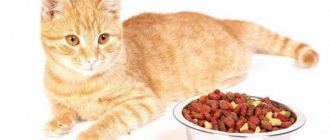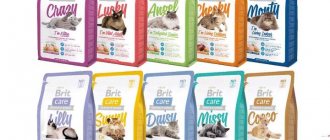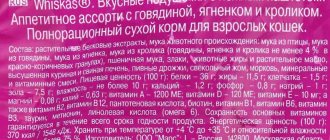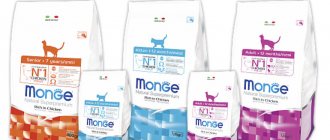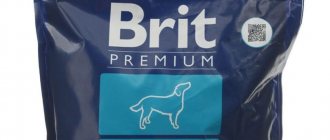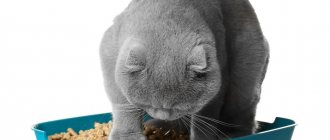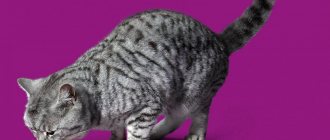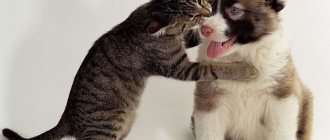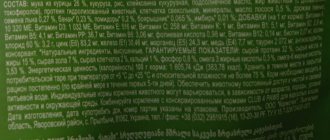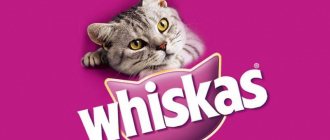On television you can often see advertisements for Whiskas ready-made cat food. Reviews about this product are very contradictory. The name of the brand is on everyone’s lips, but not all cat owners know what professional breeders and veterinarians think about it. Let's figure out what Whiskas cat food is made from, reviews of which are so different from each other. What are its advantages and disadvantages?
Types of Whiskas
Let's start studying Whiskas food. Reviews indicate that this product belongs to the economy class, which means its price is relatively low. Commercials claim that cats love this food, and this is true. But how beneficial is it for the health of baleen predators?
The food contains components of both animal and plant origin. Moreover, the bags have very appetizing names and a rich palette of flavors: rabbit, lamb, duck, trout, salmon, tuna, chicken, turkey, beef, shrimp.
The line includes food for kittens, adult and elderly animals, as well as for neutered cats prone to digestive problems and cats that do not spend time outdoors. The company produces products for short-haired and long-haired animals. Food can be dry or wet, in individual bags.
Brand Features
Why is Whiskas food so popular? Reviews say that this product is bought by owners who love their cats and want to please them with something tasty. Indeed, in the line you can find such mouth-watering items as “Stew with chicken in creamy sauce” or “Jelly with turkey and vegetables.”
Dry food is packaged in bright cardboard boxes that are easy to open and close. Wet food is sold in cans or bags in portions. You just need to open the package and put the delicious pieces into a bowl. You should know that when using dry food, the cat must have constant access to fresh water. For normal digestion, the animal must drink 3 times more water than it ate food.
Dry food is convenient to use, as it can be on the plate all day long. The contents of jelly and stew bags cannot be stored in the air for a long time.
Compound
What do they put in Whiskas for cats? Reviews say that the food suits some animals well, while in others it can cause allergic reactions. Some breeders believe that prepared foods have a negative impact on the health of cats, especially sterilized ones. There is also an opinion that Whiskas is one of the best food in the economy class category.
Its composition causes a lot of controversy. It claims ingredients such as corn gluten, wheat flour, animal and vegetable fats, poultry and fish meal, nutritional supplements, vitamins and minerals, antioxidants, brewer's yeast, carrots, cellulose, and beets.
Important author's addition
My outbred cat is eight years old, seven of which she eats Whiskas economy food, during which time she went to the vet only once - when she developed a severe allergy that caused her pet to go bald. The analysis showed that the allergic reaction was caused by a change in diet (I will not indicate which diet, but of a different type). The rest of the blood parameters were within normal limits, so everything is individual.
Composition analysis
As you can see, “plant protein extracts” come first in the composition, which means they occupy the highest proportion in the composition. This phrase usually means corn gluten, flour, and starch. Let's not forget that cats are carnivores, and the basis of their diet should be meat, not wheat and corn.
Of course, a predator cannot get enough nutrients from flour. Therefore, animal and vegetable fats are added to the feed. The only source of meat is meat and bone meal from poultry and fish. But what is this flour made from? The waste from the meat industry is used - skin trimmings, tendons, feathers, heads, paws, beaks, hooves.
Thanks to brewer's yeast, the animal's fur becomes smooth and silky. Mineral supplements and vitamins are also necessary for the cat. Carrots and beets are used to give a beautiful color to the food pieces. And in order for the cat to eat this mixture of different types of flour, flavorings and flavoring additives, so-called digests, or attractants, are added to the food.
Why do cats love Whiskas so much? Reviews from veterinarians indicate that this food uses strong flavoring additives. Animals get used to the strong taste, and everything else seems bland to them.
Which is the best Whiskas for cats? Reviews from veterinarians claim that wet food will be more beneficial for the health of the animal, since it already contains water.
Whiskas food also contains phosphorus, zinc, magnesium, calcium, taurine and folic acid, which are necessary for the animal’s metabolism.
Brand history
Whiskas was the first animal food product to be commercialized by the American company Mars. This happened in 1932, and now in terms of sales it is in first place among industrial diets for cats in the world. Divisions of this company are located all over the world, but the main representative office of Mars Petcare is located in Belgium, in Brussels. In 1991, the company began operating in Russia, and already in 1995, the first plant for the production of food for pets opened in Stupino. At the moment, there are already several feed production factories in the Russian Federation.
The pride of the company is the Waltham research and development center, located in the UK. Leading experts in the field of veterinary medicine and pet nutrition are developing new concepts that are used in ready-made food formulas for cats. One of the most famous achievements of this laboratory is the recognition of the important role of taurine in the body of cats.
Cats are not able to produce this substance on their own and can only get it from food, so Whiskas was the first food to which it was added. This was a significant breakthrough in the field of ready-made diets for domestic cats. Currently, all complete feeds include taurine.
Advantages: ready-to-use vitamins
Why is Whiskas for cats so popular? Reviews indicate that this ready-made food has a number of advantages.
“Whiskas” is ready to eat, which means you don’t have to stand at the stove to prepare dinner for your furry pet. This is especially important for owners who have a busy work schedule and do not have time to separately prepare food for the cat.
You can hear a lot of negative things about the composition of this food, but all the vitamins and minerals a cat needs are actually added to it. Still, you won’t be satisfied with vitamins alone, and cats are obligate carnivores, that is, to maintain normal life functions they need meat; plant foods cannot replace it.
Dry food slowly deteriorates in the air, which means the owner can pour the cat’s daily amount of food into a bowl and calmly go to work. The animal will be able to eat whenever it wants. Wet food should not be left out all day.
Advantages: favorite food at a low price
We cannot fail to mention the most obvious advantage – low price. True, this mostly applies to dry Whiskas. Wet food bags contain a large amount of jelly. The cat eats 3-5 packages per day. If you buy more expensive wet food with a higher meat content, then even with a high price per bag, you will save money, since the cat will eat up faster. She will only need 2-3 packs per day.
We continue to discuss Whiskas. Reviews indicate that this is one of the few economy-class foods that has different types, depending on the age, health and lifestyle of the cat.
Another advantage, although controversial, is that the animals eat the food with pleasure. For many tailed beauties, even meat does not evoke such wild delight as Whiskas. Of course, owners are pleased to see such a positive reaction and appetite from their pet. People are also attracted by the bright box, the pleasant appearance of the food, beautiful pictures and a variety of tastes. Do not forget that for cats all these attributes do not matter. All they care about is the composition.
Among the advantages of Whiskas, quick satiation of the pet is also often called. However, this is a misconception. Economy class food contains little meat and low nutritional value, therefore, the cat eats a large amount of Whiskas. Super-premium food will be needed several times less.
Disadvantages: save on health
How good is Whiskas? Reviews indicate that all economy-class food is of rather low quality. It is worth noting that there are still cheap options on the market that are significantly inferior to Whiskas in terms of the content of nutrients. You should be especially careful when buying unknown brands and brands produced by retail chains. Always read the ingredients before purchasing!
Another disadvantage can be considered the high price for canned food, taking into account the high water content and far from ideal composition.
Reviews from professional breeders and veterinarians are not reassuring - low-quality food can cause numerous gastrointestinal diseases and allergies in cats. The animal's kidneys and liver are especially at risk. Veterinarians are increasingly citing cheap, low-quality food as the cause of urolithiasis. Trying to save money on your cat's food can have a detrimental effect on your pet's health and lead to its death. Do not forget that the animal must be regularly shown to the veterinarian and, if necessary, tests done.
Benefits and harms of economical food for cats
The main advantage of Whiskas is its availability and low price per pack. It is very tasty for cats and they eat it with pleasure, quickly getting full. The owner does not need to spend time preparing food for the pet or developing its diet. Dry food lasts a long time. A wide range will allow you to choose a diet for pets with special needs.
Disputes about the dangers and benefits of Whiskas continue constantly. Doctors believe that these products cannot provide a pet with a balanced diet, since they consist of plant proteins and contain very little meat. In addition, the abundance of food additives and dyes harms the cat’s gastrointestinal tract. The American Veterinary Association has obtained information that the food is made from poor quality by-products, meat from the corpses of killed or euthanized animals, so there is no talk of benefits. After regularly consuming Whiskas in their pads, many cats develop urolithiasis. Liquid cat food in pouches is less harmful, but expensive. Pets quickly get used to the food and refuse natural food, and it is impossible to combine homemade food with factory-made food.
Source
Disadvantages: addictive
Another significant drawback of Whiskas is that cats quickly get used to it. It seems so tasty to them that the animals refuse other food. Owners who decide to switch their cats to premium and super-premium ready-made food are faced with difficulties. Higher quality brands contain significantly lower amounts of flavorings and flavorings that are considered harmful. Accordingly, they are less attractive to the animal. But still, usually one or two days are enough for cats to try new food.
Whiskas for kittens, reviews of which are generally positive, as well as a product for adults and older animals occupy a significant share of the Russian market. But more and more often, owners are asking the question: do prepared foods harm the health of their pets? We can advise one thing: pay attention not only to the price, but also to the composition.
ASSOLUX.info
I want to make a reservation right away, this post does not belong to me, but I liked the way all the pros and cons were formulated. In turn, before quoting the post, I would like to note that I completely share the author’s position. If after reading you have a desire to communicate with her (the author is a girl), I can give you contact information in a private message. “There is such a thing in the world, you most likely know about it exclusively from chocolate bars and you most likely associate it with astronomy. For almost two years of working in the pet business, this word evokes very strong feelings. This company produces the following feeds: Whiskas, Kiteket, Pedigree, Chappie. This is the most popular animal food among ordinary people. The population judges them solely on television advertising (fortunately, these are practically the only foods that are advertised on TV, with the exception of rare promotions), as well as from the experience of their closest acquaintances, therefore, the population considers these foods to be almost one of the most serious in the pet business industry, many they are trusted, and if they are not trusted, it is solely due to distrust of dry food in general. In more professional areas, opinion was developed quite a long time ago, and a completely definite one was developed. (I mean the field of veterinary medicine, professional breeding (breeders, nurseries), the field of trade in pet supplies, just people who are very interested in how to feed animals correctly). The following joke has become established among veterinarians: Martian food is our bread, as long as Mars exists, we will always have work, the day of the death of Mars will be a black day for the entire veterinary industry, it will be the day of the collapse of veterinary clinics. This is, of course, a joke, but a joke not because if Mars dies, veterinary medicine will not suffer much, but because Mars lived, Mars is alive, Mars will live now and forever and forever, Mars. But it’s my duty to reach out to at least those who can hear me, because every life of a cat and dog is sacred to me, and I will fight Mars with all the means known to me (oh, somehow pretentious). (ATTENTION: Further in the text I will talk about cats and Whiskas, but remember that without any distortion of the meaning you can change in the text the word “cat” to the word “dog”, and “Whiskas” to “Kiteket”, “Pedigree” and "Chappie")
So, I’ll give you the most popular answers to my exclamations like: “Do not feed Whiskas under any circumstances, it’s poison.” 1) Well, my cat has been eating Whiskas for several years now, and everything is fine, no problems. Yes, indeed, in my practice there have been cases where a cat was on Whiskas for up to ten, even ten years without any special symptoms. Well, ten is a rare case, almost unique, but five is welcome. In such cases, we are dealing with a cat that is clearly very strong, with simply the most powerful and unusually stable metabolism, which neutralizes all these nasty things in some way unknown to science. Most often, such cats are relatively young (that is, they began to feed relatively early, almost from childhood) and they mostly live not in Moscow or in the city at all. But in any case, the argument is simply ridiculous - so you find out that you have been feeding the cat poison for many years, but the fact that the cat still has not died makes you ask: “well, if it has not died yet, and in general looks great, then Maybe he’s not going to continue to die, so what am I going to change?” No, well, the logic is just super - if it’s gone for now, then you can continue to feed it, maybe it will survive, well, really - but what if it does survive? And I’ll tell you more, if you fed your cat Whiskas for several years without any symptoms, then even if you immediately stop the Whiskas diet and organize the most correct diet, you cannot guarantee that after some time problems will not come to light, and problems serious.
There are four of the most terrible, most poisonous animal foods on the planet - these are Whiskas and Kiteket for cats, and Pedigree and Chappy for dogs, these are economy class food, although in terms of price I would classify Whiskas as premium, but in terms of quality they are all not economy - and... well, there are simply no words... If only you knew how many thousands of animals have already died in agony from this muck, how many millions of animals are ruining their health (main diseases: terrible dermatitis: rashes, hair loss, inflammation of the anal glands, scratching on a huge area, suppuration , and so on; gastrointestinal disorders: diarrhea, constipation, colitis, enteritis, gastritis, etc.; various allergies; renal failure; pancreatitis; terrible liver diseases (the liver is the main target, and it has the most terrible problems), and of course ICD) 2) Well, my meow loves Whiskas bags so much, she’s absolutely thrilled by them, her heart bleeds not to give her at least one Whiskas bag! Yes, sachets are now, perhaps, the most popular product in Whiskas, everyone is simply obsessed with sachets, and the reasons for this are completely objective. They, like the rest of the food of Mars, contain the same hooves and feathers, but here, so that these hooves are eaten with appetite, they add, in addition to ordinary synthetic flavorings, attractants (including, probably, sexual ones), addictive substances, almost drugs, into As a result, the animal turns out to be a real drug addict who cannot eat anything but this poison.
Does this mean that you can just let everything take its course and continue feeding the cat drugs in the name of its well-being? Of course not, it will get worse and worse. Weaning a cat off pouches in serious cases is a real science. It is necessary to translate for MONTHS so that the cat does not scratch out your eyes, and so that the animal does not suffer from anorexia (refusal of food, most often the consequences of this are not only weight loss and dystrophy, the heart suffers from it in cats, as a result, heart failure is also superimposed on the picture ), or even died... First, you just add other foods to Whiskas drop by drop, and mix it with Whiskas so that the patient does not realize that there is something there, then gradually, imperceptibly for the cat, increase the content of the additive in Whiskas, so that already in the last month of transfer you spent one or two sachets a week, mixing them with other products. Well, then you can already treat the consequences of this Whiskas. As a result, even a rescued animal remains disabled forever (if fed these bags for a long time), and is forced to sit on completely tasteless medicinal food until death. The owner also pays for his frugality (he wanted to save on food), and pays a huge amount of money to the veterinarian, and then buys expensive medicinal food and medicines, and also receives wounds from his cat every time he feeds her this nasty stuff (food for liver disorders - the most tasteless food in any series of medicinal products)
Here is the simplest example of the difficulty of switching to other foods from Whiskas - the closest in parameters to Whiskas bags from serious companies are Nutro bags - also pieces, also in jelly, but much better quality and tastier, until the cat gets Whiskas, she will most likely prefer Nutra to it (although, by the way, all sorts of things have happened, during my service I have encountered such diverse taste variations that it makes my hair stand on end) BUT A CAT HOT ON WHISCAS will bury Nutra under the bowl and look at you with such a look that you will understand - you have to eat this Nutra out of there yourself! There are also variations here - some cats will attack Nyutra with pleasure, but after three bags they will say that she is full and does not want to see this product in her diet anymore, but asks for Whiskas. Many owners buy into this and say: “Oh, not Nyutra? Well, we’ll give you an Oscar, so eat it, as long as it’s not Whiskas” - and she gobbles up the Oscar bags, she gets bored with them even faster, then they give her various Gourmets, then Petritas, Shebas, Merricks, then they mercilessly pour it all over cat sauces... in general, they come to a diet that is no longer much better than Whiskas itself, but even this they will have to add Whiskas in order to wake up in the morning with eyes... And I’m not just saying this, I’ve seen all this personally, all this, the result of listening to the lamentations of a huge number of owners of the victims of Mars, whose crocodile tears have been flowing down my vest in liters for two years.
3) Well, what should I switch to? Natural feeding is very difficult and labor-intensive, and higher-quality feed costs a lot of money. No, seriously, four hundred grams of Eukanuba is one hundred and thirty rubles, but is it gold or what? Well, first of all, about the dilemma - ready-made food (dry, canned food, including bags) or natural food. Naturally, natural food is healthier, but there is no need to draw far-reaching conclusions, because it is quite correctly said that it is very difficult to feed natural food - it is difficult to feed natural food correctly. I’m telling you this as a person who spent more than a dozen hours doing one of the most terrible activities in his life - filling out huge feeding tables for cattle, pigs, chickens, horses, sheep and other living creatures. With absolutely correct feeding, it is necessary to take into account in the diet: the amount of MJ of energy, digestible protein, digestible fat, BEV, fiber, essential fatty acids, critical essential amino acids, many vitamins, many macro- and microelements. And in accordance with this, it is necessary to select ingredients of various contents and calculate their ratios in the diet, taking into account the norms for various species, breeds, physiological statuses (sex, age, weight, activity, presence of diseases, castration/sterilization, pregnancy (its duration) , products (productivity, type of product), etc.) of animals, which nowadays normal people do not do without a computer. You will say - what nonsense, cats have been fed scraps all their lives, but here are tables, nonsense! You’ll be partly right, you’ve been fed this way all your life, BUT firstly, the environment used to be much better, especially if we’re talking about a metropolis; secondly, domestic cats, even outbred ones, are subject to degeneration, and purebred cats are a completely different story, if you make a mistake with them once, or something else, then the apocalypse begins; and thirdly - well, feeding anyhow - this is actually always very bad, it’s just that before people weren’t particularly worried about this, well, according to statistics, cats live three years less than on proper nutrition - but who’s going to count that? They all live differently, one is eight, the other is eighteen, go figure which feeding is better based on this parameter. So, either we are talking about really proper feeding (okay, without tables, but so that there is a normal ratio of different types of meat, different cereals, offal in moderation, milk-based products (not milk itself), as well as additional regular the introduction of vitamins, microelements and some active additives depending on the breed of the animal is a must), or you cannot achieve this. If it’s the latter, then I tell you absolutely unequivocally - feed with professional food, and don’t lighten it! As for the form of professional food. There is a completely established stereotype that ready-made food, no matter what it is, is a very terrible thing. The stereotype is wrong, but its reasons are objective - millions of cats have died from Whiskas, how could dry food have a good reputation? Naturally, in Russia the impression was created of this type of product as poison, but in reality everything depends on the manufacturer. The quality of dry food from different manufacturers differs from each other, just like day and night, and the whole bad reputation of drying comes precisely from Whiskas and others like them; veterinarians of older generations have developed a conditioned migraine reflex at the mention of dry feeding, and many have not gotten rid of It still is, when the market is filled with a wide variety of products. In addition, in order not to complain about dry food, we must remember that even the best dry food is still a specific food, it is not the food to which the body of a given type of animal has been accustomed, adapted, and adjusted for millions of years, and therefore even the highest quality the food must be used in accordance with certain simple rules, the implementation of which is absolutely necessary, otherwise the effect of the most expensive food will be the same as that of Whiskas.
These rules are: a) do not mix different brands of food in the diet; you should choose one that suits your cat’s budget, quality, and taste, and diversify the diet exclusively within this brand. And don’t be afraid that you are feeding the same thing, that’s the difference between Prof. food from natural - dietetics with natural food requires as much variety as possible, it is impossible to eat only chicken or rice, but just one type of prof. You can and should eat food - because there is chicken, rice, and everything else in the right proportions, this is a mini-copy of your cat’s material composition. The main thing is just to get used to this food, this is due precisely to the specificity of the ready-made food - no matter how high-quality and expensive the food is, it is still not natural for the cat, it is necessary to adapt to it - both for the cat itself and its digestion, especially the liver. The liver must find the most optimal version of its work in order to digest this food, harmoniously, and “cooperate” with it. b) if you decide to switch to dry food, we exclude natural food almost completely; it also cannot be combined with drying, just like drying foods of different brands. c) you should choose the right food formula; different formulas are different for different cats; it is best to consult sellers in pet stores about this. Never hesitate to ask sellers, they are obliged to know and report what you need to feed your cat, for this they must ask you at least four questions: type of animal, age, breed (or weight of the breed in adulthood), the presence of any features. If these conditions are met, everything will be fine for you (well, with the exception of special situations, such as individual intolerance, allergic reactions, the absence of which cannot be guaranteed under absolutely any type of feeding if the animal is purebred) So I explained that even You can easily sit on professional food for a very long time and happily, but there is a choice among professional ones - either dry food or canned food. Here we must remember that, in principle, these two types are no different (if they are from the same company), are equally useful, you can live on them for the same long time, and they are interchangeable and complementary, that is, if they are from the same company, then you can mix or alternate in different ratios (but again, maintain consistency, so you decided, say, half drying, half canned food - so let’s always do that, you decided that canned food in the morning, drying in the evening - be consistent in this too). Be guided in choosing dry/canned food according to your cat’s taste; many simply don’t like dry food, but love canned food, especially love pieces in sauce, or there is a special problem - the cat doesn’t know how to drink. Yes, and this happens quite often, then dry wood is excluded. In turn, dry food is more attractive due to its cost-effectiveness. Remember that canned food is a very small amount of food in jars at a relatively high cost and an additional 80% water. Otherwise, distrust of dry bread is a pure stereotype; we simply associate it with crackers: well, some kind of cookie, how can you force a cat to live on crackers? You will often come across an emotional attack: “Just sit on some crackers yourself, let’s see how you sing about dietetics.” No, comrades, these are not crackers, this is a complete diet, there is absolutely everything that is canned, and if it is high-quality food, then it is made, it is prepared using such technology that it is tasty, it is nutritious, and fully meets all needs. Unlike us, the people who burned themselves on Whiskas in the nineties and are still blowing all over the dry land, Western European countries and America have been living on dry food for over seventy years, they have lost both euphoria and phobia, they have lived a long and happy life on them more than a dozen generations of meows and woofs, and there is no bad reputation for dry land. And speaking of prices. High-quality dry food is very expensive, BUT when calculating your losses, remember that the daily requirement when feeding high-quality food is much lower than with economy-class or natural food. This is due, firstly, to high-quality, highly digestible ingredients, that is, a larger proportion can be absorbed into the animal’s body, and secondly, to the balance of these same ingredients, because the animal needs to consume not a specific mass, but a certain mass of each nutrient, as a result, if If one substance is in excess and another is in short supply, then the excess will partially come out unused. In a formula where there is no excess, everything is used to the maximum.
Well, we come to the culmination of the topic - what quality food do you bestow on your creature? Only for my readers, an exclusive detailed summary rating of cat and dog food on the Russian market in accordance with the quality of food, the result of my experience, the experience of many dozens of my colleagues, the experience of hundreds of my clients and thousands of clients of my colleagues.
I don’t think that this is an advertisement, because I don’t give preference to one particular food, but highlight three foods equally (yes, it’s really very difficult to choose between these three foods, everyone has a different opinion, and different animals also give their preferences differently them), so I allow myself to show you this rating, but still warn you that this is my purely subjective opinion, not confirmed by any official research, and I could be wrong here on different scales, and I provide a list: A rating of food is given with their rating according to hundred point scale. The limit of the scale is not an ideal food; no one has created an ideal food, but a food better than which has not yet been invented among mass-produced food.
90-100 - the best feed, excellent quality, the most serious technologies and developments, expensive feed, but very healthy, and the daily norm is low due to the highest balance, that is, almost everything is digested, it is even noticeable that less feces are excreted - all in energy, think for yourself; for most cats, a two-kilogram package for four hundred rubles lasts almost a month, and for some, over a month. Many representatives of these companies also have medicinal foods that restore pets after various diseases, including those caused by low-quality competitors. 75-90 are good feeds, if you are already on them, then you shouldn’t change to first category feeds at all - these are also quite suitable. It even happens that some food of the first category causes various allergic reactions, and you have to look for alternatives in this category, but if you are looking and if you are not burdened with financial difficulties, it is better to start with the first category 50-75 - inexpensive food, satisfactory quality, but the daily norm is slightly higher than that of the best, it is advisable to additionally introduce vitamins into the diet. Most dogs, and even some purebred ones, will live well on these foods, but there are often problems, look at the circumstances and financial situation, and remember that the savings are not very noticeable if you are burdened with the purchase of vitamins and due to the relatively increased daily allowance the norm is 25-50 - economical feed, but the quality is not high, there is little digestible protein, few vitamins, not very balanced, the ingredients are not particularly selected, but most outbred animals are able to sit on this without any special health problems. I really don’t recommend feeding kittens (puppies) with them, even with special formulas for kittens from the same company, but after reaching at least two years of age, if your financial situation does not allow anything more serious, you can afford such a diet. 10-25 - cheap low-quality feed, there is practically no meat, there is nothing to put it here, basically all millet, bran, meat production waste, sources of animal tissue - offal, which in general is not bad, but not in such quantities, according to There is generally silence about vitamins, except perhaps for low-income owners or fanatical owners of a zoo in the house, which, even with such a diet, eats up the bulk of the income. It’s amazing how long an animal will live, but many live even for a very long time and without any special health problems, they get used to this, it’s not for nothing that they say “it will heal like a dog,” or “a cat has nine lives.” They adapt to look for scraps, save vitamins in the liver to the last crumb, and even reproduce well. 0-10 is an excellent choice for flayers, much better than strychnine - it’s too fast, you don’t have time to get full pleasure from contemplating the terrible torment of your charges. An interesting fact is that food in this category is not the cheapest, the penultimate category is cheaper on average, apparently a sadistic service is included in the price of the product, in addition to the cost of hooves, feathers, intestines, peelings and drugs.
So the rating (too lazy to write in Latin, I’ll dabble in the Cyrillic alphabet, if you have any questions, ask in the comments, also ask if you didn’t find your brand on the list - there are so many of them that you can’t remember them all overnight): Hills - 100 Nutro Choice - 100 Eukanuba - 99 Eagle Pak - 95 Bosch - 95 Yams - 93 Biomill - 89 Pro Plan - 89 Royal Canin France - 88 Nutro Gold - 85 Nutro Nuggets - 85 Pro Pak USA - 85 Flatazor - 82 Leonardo - 80 Belcando - 80 Diamond - 79 Pro Pak Ukraine - 78 Royal Canin Russia - 77 Dr. Alders Nature Coast - 75 Gimpet - 72 Dr. Alders - 50 - 70 (different formulas) Gurmet - 55 and 65 (different formulas) Sheba - 67 Purina - 60 Dr. Clouder - 45 Friskies — 43 May Lord — 40 May Lady — 40 Oscar — 38 Gourmet — 26 Max — 22 Vaska — 15 Meal — 13 Whiskas — 3 Pedigree — 3 Chappie — 1 Kitekat — 1
I really want to hope that my efforts will not be in vain, and somewhere else another cat will live a longer and happier life with its owner. Thank you for your attention. "
